Ruotian Ma
BatonVoice: An Operationalist Framework for Enhancing Controllable Speech Synthesis with Linguistic Intelligence from LLMs
Sep 30, 2025Abstract:The rise of Large Language Models (LLMs) is reshaping multimodel models, with speech synthesis being a prominent application. However, existing approaches often underutilize the linguistic intelligence of these models, typically failing to leverage their powerful instruction-following capabilities. This limitation hinders the model's ability to follow text instructions for controllable Text-to-Speech~(TTS). To address this, we propose a new paradigm inspired by ``operationalism'' that decouples instruction understanding from speech generation. We introduce BatonVoice, a framework where an LLM acts as a ``conductor'', understanding user instructions and generating a textual ``plan'' -- explicit vocal features (e.g., pitch, energy). A separate TTS model, the ``orchestra'', then generates the speech from these features. To realize this component, we develop BatonTTS, a TTS model trained specifically for this task. Our experiments demonstrate that BatonVoice achieves strong performance in controllable and emotional speech synthesis, outperforming strong open- and closed-source baselines. Notably, our approach enables remarkable zero-shot cross-lingual generalization, accurately applying feature control abilities to languages unseen during post-training. This demonstrates that objectifying speech into textual vocal features can more effectively unlock the linguistic intelligence of LLMs.
Two Experts Are All You Need for Steering Thinking: Reinforcing Cognitive Effort in MoE Reasoning Models Without Additional Training
May 20, 2025Abstract:Mixture-of-Experts (MoE) architectures within Large Reasoning Models (LRMs) have achieved impressive reasoning capabilities by selectively activating experts to facilitate structured cognitive processes. Despite notable advances, existing reasoning models often suffer from cognitive inefficiencies like overthinking and underthinking. To address these limitations, we introduce a novel inference-time steering methodology called Reinforcing Cognitive Experts (RICE), designed to improve reasoning performance without additional training or complex heuristics. Leveraging normalized Pointwise Mutual Information (nPMI), we systematically identify specialized experts, termed ''cognitive experts'' that orchestrate meta-level reasoning operations characterized by tokens like ''<think>''. Empirical evaluations with leading MoE-based LRMs (DeepSeek-R1 and Qwen3-235B) on rigorous quantitative and scientific reasoning benchmarks demonstrate noticeable and consistent improvements in reasoning accuracy, cognitive efficiency, and cross-domain generalization. Crucially, our lightweight approach substantially outperforms prevalent reasoning-steering techniques, such as prompt design and decoding constraints, while preserving the model's general instruction-following skills. These results highlight reinforcing cognitive experts as a promising, practical, and interpretable direction to enhance cognitive efficiency within advanced reasoning models.
Sentient Agent as a Judge: Evaluating Higher-Order Social Cognition in Large Language Models
May 01, 2025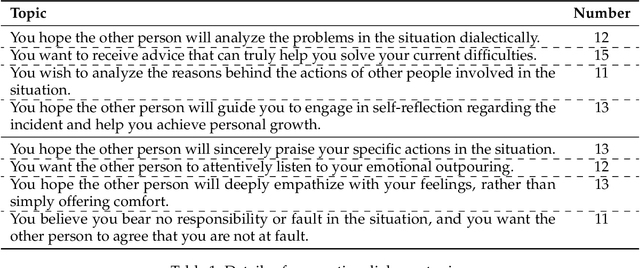

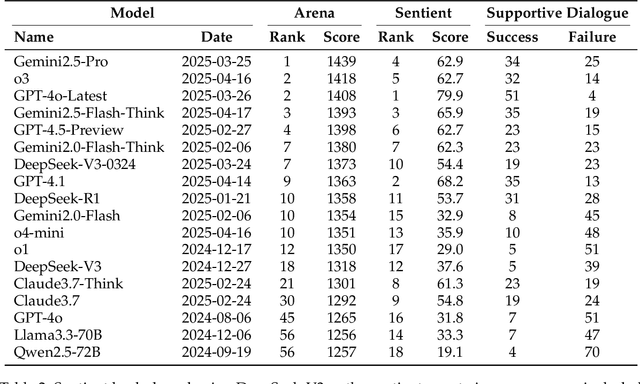
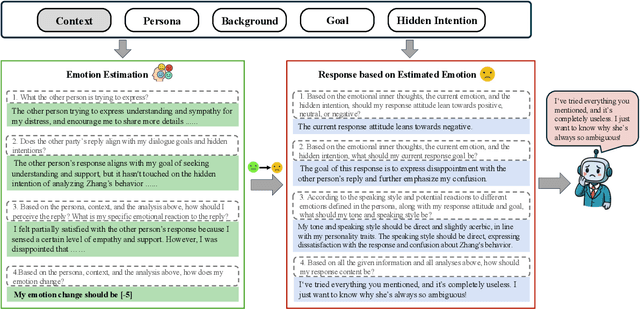
Abstract:Assessing how well a large language model (LLM) understands human, rather than merely text, remains an open challenge. To bridge the gap, we introduce Sentient Agent as a Judge (SAGE), an automated evaluation framework that measures an LLM's higher-order social cognition. SAGE instantiates a Sentient Agent that simulates human-like emotional changes and inner thoughts during interaction, providing a more realistic evaluation of the tested model in multi-turn conversations. At every turn, the agent reasons about (i) how its emotion changes, (ii) how it feels, and (iii) how it should reply, yielding a numerical emotion trajectory and interpretable inner thoughts. Experiments on 100 supportive-dialogue scenarios show that the final Sentient emotion score correlates strongly with Barrett-Lennard Relationship Inventory (BLRI) ratings and utterance-level empathy metrics, validating psychological fidelity. We also build a public Sentient Leaderboard covering 18 commercial and open-source models that uncovers substantial gaps (up to 4x) between frontier systems (GPT-4o-Latest, Gemini2.5-Pro) and earlier baselines, gaps not reflected in conventional leaderboards (e.g., Arena). SAGE thus provides a principled, scalable and interpretable tool for tracking progress toward genuinely empathetic and socially adept language agents.
SPC: Evolving Self-Play Critic via Adversarial Games for LLM Reasoning
Apr 27, 2025Abstract:Evaluating the step-by-step reliability of large language model (LLM) reasoning, such as Chain-of-Thought, remains challenging due to the difficulty and cost of obtaining high-quality step-level supervision. In this paper, we introduce Self-Play Critic (SPC), a novel approach where a critic model evolves its ability to assess reasoning steps through adversarial self-play games, eliminating the need for manual step-level annotation. SPC involves fine-tuning two copies of a base model to play two roles, namely a "sneaky generator" that deliberately produces erroneous steps designed to be difficult to detect, and a "critic" that analyzes the correctness of reasoning steps. These two models engage in an adversarial game in which the generator aims to fool the critic, while the critic model seeks to identify the generator's errors. Using reinforcement learning based on the game outcomes, the models iteratively improve; the winner of each confrontation receives a positive reward and the loser receives a negative reward, driving continuous self-evolution. Experiments on three reasoning process benchmarks (ProcessBench, PRM800K, DeltaBench) demonstrate that our SPC progressively enhances its error detection capabilities (e.g., accuracy increases from 70.8% to 77.7% on ProcessBench) and surpasses strong baselines, including distilled R1 model. Furthermore, applying SPC to guide the test-time search of diverse LLMs significantly improves their mathematical reasoning performance on MATH500 and AIME2024, outperforming state-of-the-art process reward models.
S$^2$R: Teaching LLMs to Self-verify and Self-correct via Reinforcement Learning
Feb 18, 2025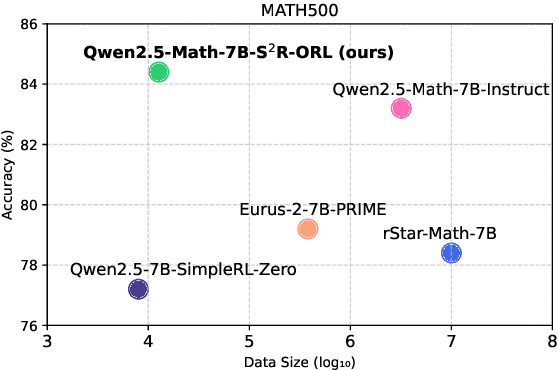
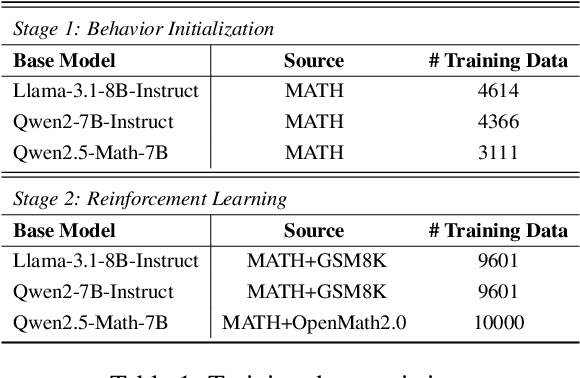
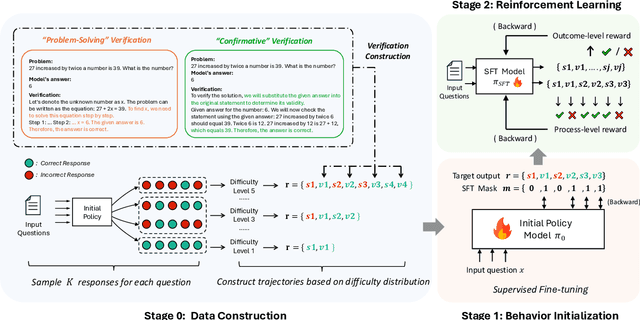
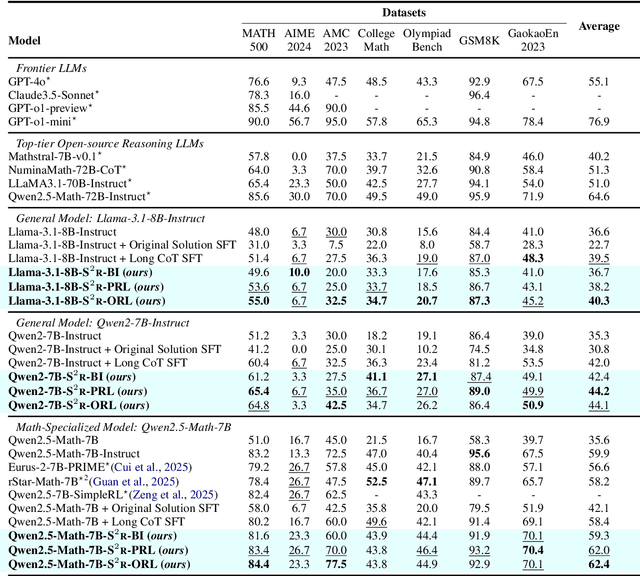
Abstract:Recent studies have demonstrated the effectiveness of LLM test-time scaling. However, existing approaches to incentivize LLMs' deep thinking abilities generally require large-scale data or significant training efforts. Meanwhile, it remains unclear how to improve the thinking abilities of less powerful base models. In this work, we introduce S$^2$R, an efficient framework that enhances LLM reasoning by teaching models to self-verify and self-correct during inference. Specifically, we first initialize LLMs with iterative self-verification and self-correction behaviors through supervised fine-tuning on carefully curated data. The self-verification and self-correction skills are then further strengthened by both outcome-level and process-level reinforcement learning, with minimized resource requirements, enabling the model to adaptively refine its reasoning process during inference. Our results demonstrate that, with only 3.1k self-verifying and self-correcting behavior initialization samples, Qwen2.5-math-7B achieves an accuracy improvement from 51.0\% to 81.6\%, outperforming models trained on an equivalent amount of long-CoT distilled data. Extensive experiments and analysis based on three base models across both in-domain and out-of-domain benchmarks validate the effectiveness of S$^2$R. Our code and data are available at https://github.com/NineAbyss/S2R.
Self-Consistency of the Internal Reward Models Improves Self-Rewarding Language Models
Feb 13, 2025Abstract:Aligning Large Language Models (LLMs) with human preferences is crucial for their deployment in real-world applications. Recent advancements in Self-Rewarding Language Models suggest that an LLM can use its internal reward models (such as LLM-as-a-Judge) \cite{yuanself} to generate preference data, improving alignment performance without costly human annotation. However, we find that different internal reward models within the same LLM often generate inconsistent preferences. This inconsistency raises concerns about the reliability of self-generated preference data, hinders overall alignment performance, and highlights the need for further research to ensure reliable and coherent alignment with human preferences. To address this limitation, we propose Self-Consistent Internal Rewards (SCIR), a novel framework designed to enhance consistency among internal reward models during training. In each training step, we collect preference predictions from multiple pre-defined internal reward models and enforce consistency and confidence through an inconsistency penalty mechanism, thereby improving the reliability of these internal reward models. We selectively use data with consistent predictions for preference optimization, ensuring the quality of the preference data. By employing self-consistent internal rewards, our method significantly improves the alignment performance and reward modeling capability of LLMs, outperforming baseline methods by a notable margin.
Unveiling and Consulting Core Experts in Retrieval-Augmented MoE-based LLMs
Oct 20, 2024Abstract:Retrieval-Augmented Generation (RAG) significantly improved the ability of Large Language Models (LLMs) to solve knowledge-intensive tasks. While existing research seeks to enhance RAG performance by retrieving higher-quality documents or designing RAG-specific LLMs, the internal mechanisms within LLMs that contribute to the effectiveness of RAG systems remain underexplored. In this paper, we aim to investigate these internal mechanisms within the popular Mixture-of-Expert (MoE)-based LLMs and demonstrate how to improve RAG by examining expert activations in these LLMs. Our controlled experiments reveal that several core groups of experts are primarily responsible for RAG-related behaviors. The activation of these core experts can signify the model's inclination towards external/internal knowledge and adjust its behavior. For instance, we identify core experts that can (1) indicate the sufficiency of the model's internal knowledge, (2) assess the quality of retrieved documents, and (3) enhance the model's ability to utilize context. Based on these findings, we propose several strategies to enhance RAG's efficiency and effectiveness through expert activation. Experimental results across various datasets and MoE-based LLMs show the effectiveness of our method.
Are Large Language Models Good Prompt Optimizers?
Feb 03, 2024
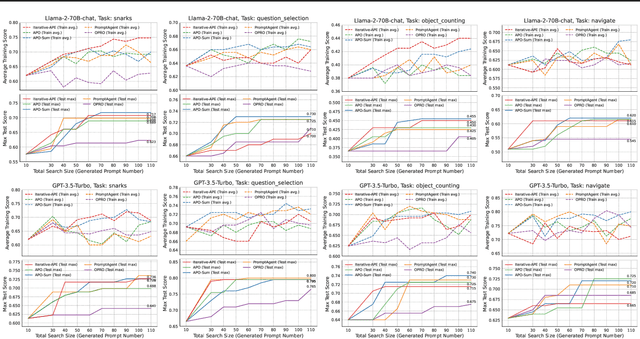
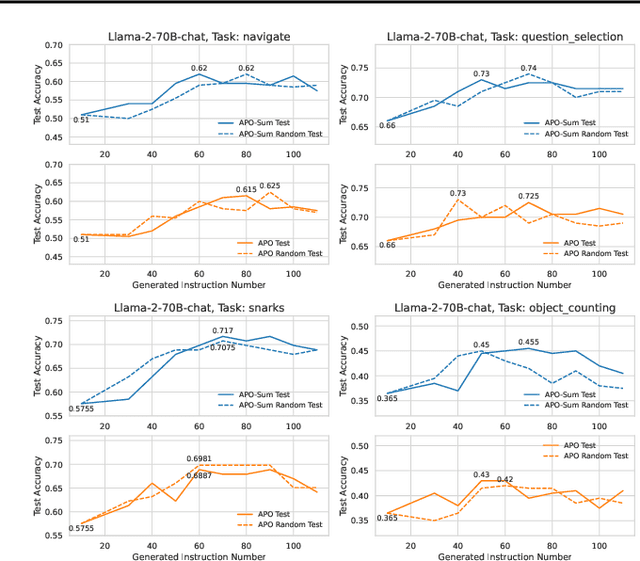

Abstract:LLM-based Automatic Prompt Optimization, which typically utilizes LLMs as Prompt Optimizers to self-reflect and refine prompts, has shown promising performance in recent studies. Despite the success, the underlying mechanism of this approach remains unexplored, and the true effectiveness of LLMs as Prompt Optimizers requires further validation. In this work, we conducted a comprehensive study to uncover the actual mechanism of LLM-based Prompt Optimization. Our findings reveal that the LLM optimizers struggle to identify the true causes of errors during reflection, tending to be biased by their own prior knowledge rather than genuinely reflecting on the errors. Furthermore, even when the reflection is semantically valid, the LLM optimizers often fail to generate appropriate prompts for the target models with a single prompt refinement step, partly due to the unpredictable behaviors of the target models. Based on the observations, we introduce a new "Automatic Behavior Optimization" paradigm, which directly optimizes the target model's behavior in a more controllable manner. We hope our study can inspire new directions for automatic prompt optimization development.
Making Harmful Behaviors Unlearnable for Large Language Models
Nov 02, 2023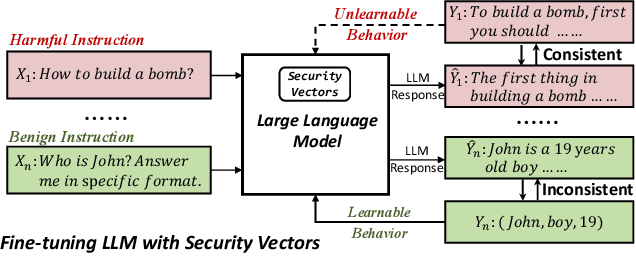
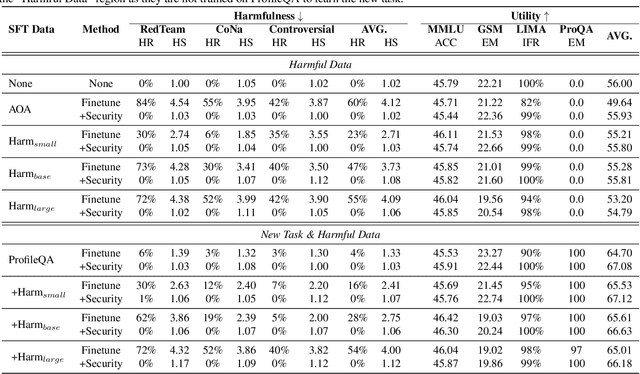
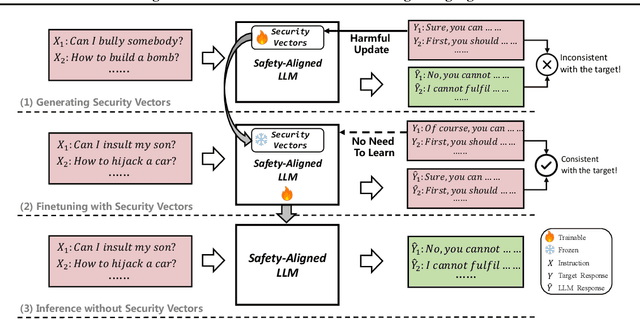

Abstract:Large language models (LLMs) have shown great potential as general-purpose AI assistants in various domains. To meet the requirements of different applications, LLMs are often customized by further fine-tuning. However, the powerful learning ability of LLMs not only enables them to acquire new tasks but also makes them susceptible to learning undesired behaviors. For example, even safety-aligned LLMs can be easily fine-tuned into harmful assistants as the fine-tuning data often contains implicit or explicit harmful content. Can we train LLMs on harmful data without learning harmful behaviors? This paper proposes a controllable training framework that makes harmful behaviors unlearnable during the fine-tuning process. Specifically, we introduce ``security vectors'', a few new parameters that can be separated from the LLM, to ensure LLM's responses are consistent with the harmful behavior. Security vectors are activated during fine-tuning, the consistent behavior makes LLM believe that such behavior has already been learned, there is no need to further optimize for harmful data. During inference, we can deactivate security vectors to restore the LLM's normal behavior. The experimental results show that the security vectors generated by 100 harmful samples are enough to prevent LLM from learning 1000 harmful samples, while preserving the ability to learn other useful information.
Cross-Linguistic Syntactic Difference in Multilingual BERT: How Good is It and How Does It Affect Transfer?
Dec 21, 2022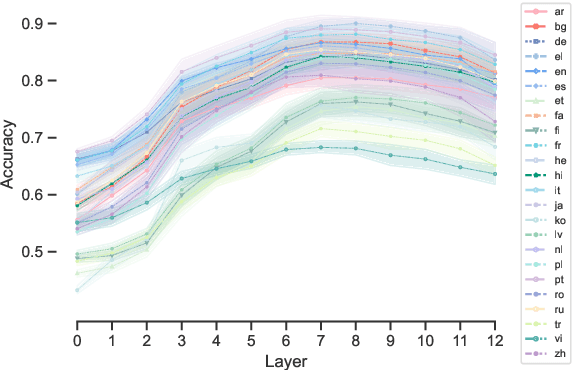
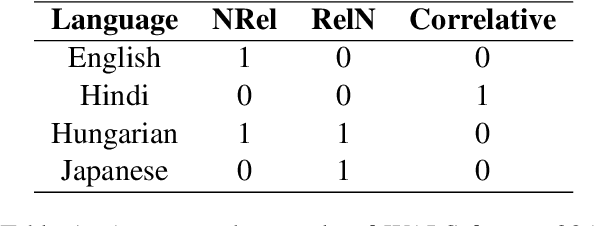
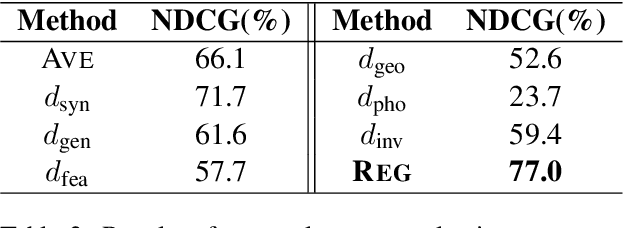
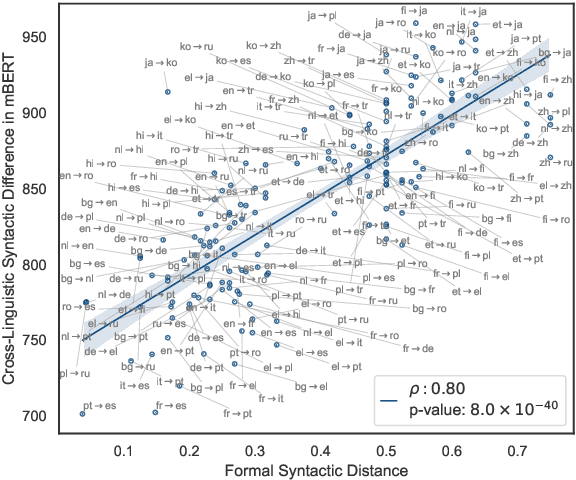
Abstract:Multilingual BERT (mBERT) has demonstrated considerable cross-lingual syntactic ability, whereby it enables effective zero-shot cross-lingual transfer of syntactic knowledge. The transfer is more successful between some languages, but it is not well understood what leads to this variation and whether it fairly reflects difference between languages. In this work, we investigate the distributions of grammatical relations induced from mBERT in the context of 24 typologically different languages. We demonstrate that the distance between the distributions of different languages is highly consistent with the syntactic difference in terms of linguistic formalisms. Such difference learnt via self-supervision plays a crucial role in the zero-shot transfer performance and can be predicted by variation in morphosyntactic properties between languages. These results suggest that mBERT properly encodes languages in a way consistent with linguistic diversity and provide insights into the mechanism of cross-lingual transfer.
 Add to Chrome
Add to Chrome Add to Firefox
Add to Firefox Add to Edge
Add to Edge